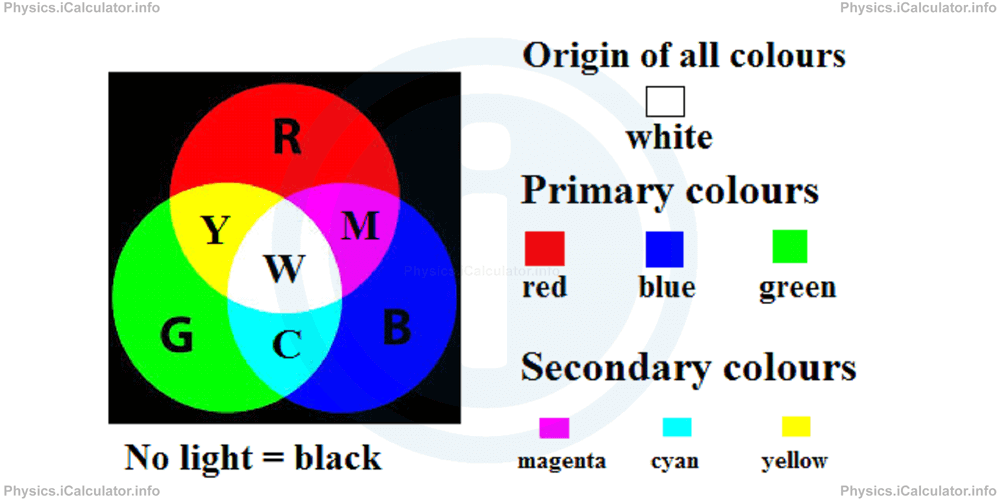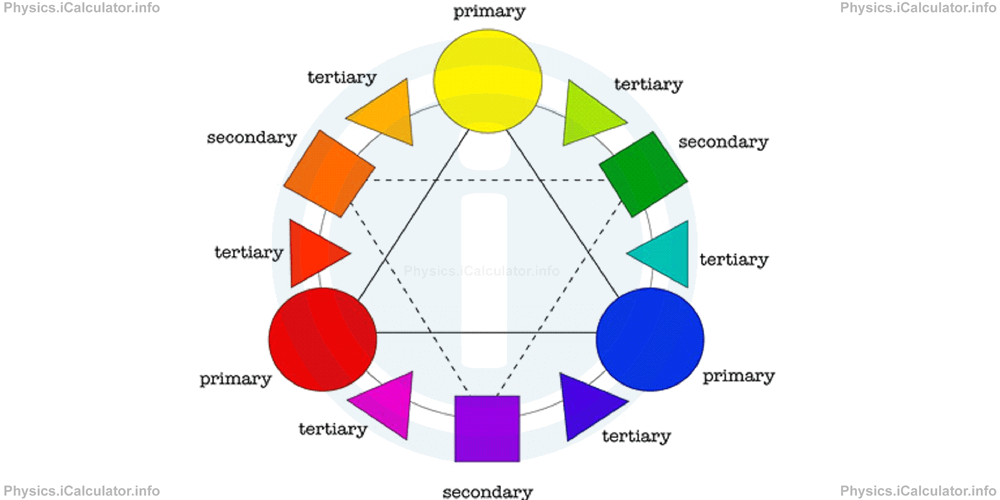Menu
Physics Lesson 12.5.3 - Primary, Secondary and Tertiary Colours of Light
Please provide a rating, it takes seconds and helps us to keep this resource free for all to use
Welcome to our Physics lesson on Primary, Secondary and Tertiary Colours of Light, this is the third lesson of our suite of physics lessons covering the topic of Dispersion of Light, you can find links to the other lessons within this tutorial and access additional physics learning resources below this lesson.
Primary, Secondary and Tertiary Colours of Light
Although we see seven colours when white light disperses through prisms, only three of them are primary, i.e. are not produced by combinations of other colours. These primary colours are red, green and blue. Indeed, we hardly see all seven colours during dispersion because the three primary colours are more visible than the others.
On the other hand, three other colours known as secondary colours are obtained by combining two primary colours. They are magenta, cyan and yellow. Thus, magenta is obtained by combining red and blue, cyan by combining green and blue, and yellow light is obtained by combining red and green. Look at the figure below.

The other colours not mentioned in the above categories, are obtained by combining one primary and one secondary colour of light. These colours are known as tertiary or intermediate. For example, if you mix cyan and blue you obtain a new colour known as azure, by mixing blue and magenta you obtain violet etc.

There are also quaternary and quinary colours obtained by mixing two tertiary and quaternary colours respectively. However, we will stop here with colours as this is not an advanced tutorial aiming to explain in detail the colours of light but simply a generic tutorial on dispersion of light waves.
Remark! In the Theory of Light, red, blue and green are the primary colours. However, in Painting Theory used in art, the three primary colours are red, yellow and blue. As a result, the secondary and tertiary colours in art are a little different to those in optics. This may cause a bit confusion when doing a research in internet. Hence, it is important to specify the field when you are browsing online for colours.
Example 1
A student is trying to find a relationship between colours and he chooses the wavelength as criterion to consider when working to prove his assumption. The student claims that secondary colours are obtained when mixing two primary colours in equal amount. Is his assumption correct? Explain.
Solution 1
From the table below showing the wavelengths of the (seven) rainbow's colours
Red → 700 nm - 635 nm
Orange → 635 nm - 590 nm
Yellow → 590 nm - 560 nm
Green → 560 nm - 520 nm
Cyan → 520 nm - 490 nm
Blue → 490 nm - 450 nm
Violet → 450 nm - 400 nm
we obtain the following typical values for the three primary colours, red, green and blue (typical values are taken near the middle of each wavelength range. Thus, for red colour, we take 670 nm, for green 540 nm and for blue 470 nm as typical wavelengths.
By combining blue and green in equal amounts (based on the student's assumption), we obtain
= 470 nm + 540 nm/2
= 505 nm
This wavelength belongs to cyan colour as supposed.
On the other hand, when mixing red and blue in equal amounts, we obtain
= 470 nm + 670 nm/2
= 570 nm
This colour belongs to the yellow part of visible light spectrum, not magenta.
Finally, when mixing red and green light in equal amounts, we obtain
= 670 nm+540 nm/2
= 605 nm
This wavelength belongs to orange part of visible light spectrum, not yellow. Therefore, the student's assumption is not correct, as the colours obtained during the colours mixing process in equal amount do not correspond to the expected colours.
You have reached the end of Physics lesson 12.5.3 Primary, Secondary and Tertiary Colours of Light. There are 4 lessons in this physics tutorial covering Dispersion of Light, you can access all the lessons from this tutorial below.
More Dispersion of Light Lessons and Learning Resources
Whats next?
Enjoy the "Primary, Secondary and Tertiary Colours of Light" physics lesson? People who liked the "Dispersion of Light lesson found the following resources useful:
- Colours Feedback. Helps other - Leave a rating for this colours (see below)
- Optics Physics tutorial: Dispersion of Light. Read the Dispersion of Light physics tutorial and build your physics knowledge of Optics
- Optics Revision Notes: Dispersion of Light. Print the notes so you can revise the key points covered in the physics tutorial for Dispersion of Light
- Optics Practice Questions: Dispersion of Light. Test and improve your knowledge of Dispersion of Light with example questins and answers
- Check your calculations for Optics questions with our excellent Optics calculators which contain full equations and calculations clearly displayed line by line. See the Optics Calculators by iCalculator™ below.
- Continuing learning optics - read our next physics tutorial: Polarization of Light
Help others Learning Physics just like you
Please provide a rating, it takes seconds and helps us to keep this resource free for all to use
We hope you found this Physics lesson "Dispersion of Light" useful. If you did it would be great if you could spare the time to rate this physics lesson (simply click on the number of stars that match your assessment of this physics learning aide) and/or share on social media, this helps us identify popular tutorials and calculators and expand our free learning resources to support our users around the world have free access to expand their knowledge of physics and other disciplines.